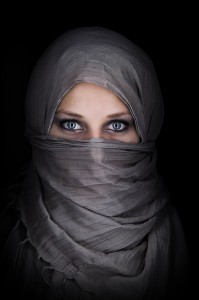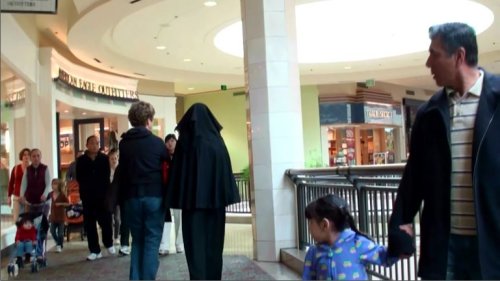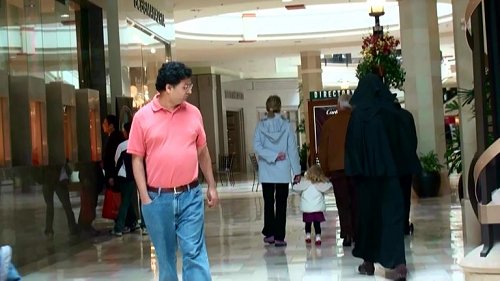 My curiosity to try wearing the most conservative Muslim, black Burqa drapery in California overcame my dread that I would be found out by a Muslim who might eagerly approach me as any of us might do when we find “our kind” in a foreign land. I was fearful of offending, or appearing to make light of a serious cultural tradition. It took an immense amount of courage to overcome my trepidation. But at last I decided to just go for it. Logically speaking no one would even know who I was anyway even if they approached me. But clearly physical invisibility does not give free reign to moral laxity.
My curiosity to try wearing the most conservative Muslim, black Burqa drapery in California overcame my dread that I would be found out by a Muslim who might eagerly approach me as any of us might do when we find “our kind” in a foreign land. I was fearful of offending, or appearing to make light of a serious cultural tradition. It took an immense amount of courage to overcome my trepidation. But at last I decided to just go for it. Logically speaking no one would even know who I was anyway even if they approached me. But clearly physical invisibility does not give free reign to moral laxity.
I recall first being introduced to the religious tradition years ago in the Versailles gardens outside Paris when I saw a group of black-veiled women, with only their eyes peering out of narrow slits. I remember being both fascinated and repulsed by something so foreign to my awareness and so contrary to my perceptions of what equality and freedom means.
More recently I returned from Turkey just a few months ago. Intrigued with anything that starkly contrasts my own experience of life, I asked my Turkish host to take me to the most conservative neighborhood in Istanbul. There I saw groups of black-clad women wandering amongst themselves or with children in tow along the Bosphorus. I remember a sinking sense of both fascination and repugnance with an aftermath of wondering. Could these women really be educated? If those veils were removed would I see some psychologically stunted version of womanhood? Despite logic that told me otherwise, the visual prompted such a weighty emotional response, that I almost persuaded myself to think they somehow couldn’t quite be fully human, that the symbolic and literal limits the burqa puts on the wide range of human experience must thwart their psychological development.
On the flight home from Turkey my mom and I had the good fortune of sitting next to a burqa-clad woman. We observed her interactions with the world through just slits in her eyes. Underneath the multi-layered black drapery, we noticed her hands and arms were covered in long black gloves. Her children and husband sat around her. When she ate she lifted the veil slightly and maneuvered food underneath toward her mouth. She was very attentive to her children, catering to their every need.
We stepped through the thick barriers that such attire raises and initiated conversation. She spoke perfect English. We could hear her personality. She was on a plane for the first time, coming from Egypt to live in St. Louis with her husband who was beginning his medical residency. She was worried about being away from her parents for so long. She had never been away from her family for more than a few weeks at a time. We learned she held a Masters in Engineering. Just one simple conversation on an airplane did so much to break through our emotionally charged reactions that had within seconds of seeing burqa-clad women for the first time, built up in our educated and worldly minds potentially deep barriers to connecting.
Now back in the US, I wanted to try wearing the burqa that I had purchased for several reasons. I trusted that sensory engagement could inspire fresh insights and perspective that would move me beyond my initial shock, fascination, and narrow-minded reactions. I wanted to move into deeper understanding of what it is like to wear the veil in an environment where the veil is not naturally understood.
I also wanted to experience as a newcomer to the burqa-wearing tradition what it’s like to put on a full-bodied shroud for the very first time. I wanted to know what it feels like to be made invisible to the public – to be severely limited in expressing gratitude, irritation, pleasure, frustration and the thousands of subtle emotions we express every second non-verbally.
I made no pretensions toward an outcome that would leave me with deep knowledge about the burqa wearing tradition and the experience of Muslim women who veil – an outcome which would only come from engaging a range of Muslim perspectives and scholarship.
So I went to Trader Joe’s in my burqa. The emotional preparation took far more energy and time than the 15 minutes spent shopping. I found myself laughing from nervous energy as I walked through the store, but fortunately the burqa provides very nice comfort and protection – a real shelter at times, I imagine, for introverts like me.
The reactions of most shoppers were controlled and contained. They were politely reserved, many seeming unfazed by this menacing dark figure crossing their path. Perhaps cultural norms to mask anything that could reveal a true expression of our feelings have effectively trained spontaneity out of our faces. Or perhaps we are well accustomed to the bizarre. Some people, though, were unable to easily control their reactions. I noticed their startled faces when they looked up, followed by a quick return to composure and then a stoic expression perceptively different from the casual passerby strolling unaware. Only when I scanned the room did I witness shoppers with childlike curiosity stealing glances from a distance. Perhaps a foreigner visiting the US for the first time might surmise that Americans only become congruent with their emotions from a distance. Americans would probably call themselves polite.
Wearing the burqa was like entering into a video game where, without peripheral vision and context, all I could see were figures coming my way. Was my experience of these startled-turned-stoic expressions in front of me reflective of what it is like for minorities whose differences may threaten comfort zones? For the disabled? For the homeless? What would it be like to always see looks of surprise or disturbance followed by containment?
The man in the checkout line behind me seemed particularly fascinated. I couldn’t read his expression, whether he was disgusted or enthralled, and whether this was the first time in his life he had seen such attire. The checkout lady handled me nonchalantly, beginning with a cheery “Hello. How are you?” and ending with a “Good bye, dear.”
A month later I gathered the courage to wear my burqa again. My mother agreed to accompany me and serve as an additional observer unhampered by limits to her peripheral vision. We visited the Christmas display in downtown San Jose. The central square was filled with animated elves, dancing reindeer, tinsel covered trees and strolling families, some ice-skating under the palm encircled outdoor arena. We sat on a bench to take in the sights and secretly observe reactions to our presence. Before long we noticed the police. One stood nearby, talking intently on his radio and two more passed separately in front of us. Given that the police do not normally enter into our daily reality, my mother briefly wondered if they were purposefully remaining close to us. Next we returned to the parking garage and our car to get money for drinks at the upscale Fairmont hotel. As we left the elevator and walked toward our car, I recall a security attendant dashing out of the next elevator with unusual vim into the vacant parking garage. Was I overreacting or was he following us?
The lounge of the Fairmont hotel was elegantly decorated with several Christmas trees and beautifully dressed couples. My amiable mother navigated through the crowded room with her daughter looking like Darth Vader, to find a place to sit. We perused the drink list and I secretly worried what an attentive and knowledgeable observer of this conservative Muslim attire might wonder about a Burqa-clad woman, with stylish shoes and bare hands, consuming alcohol.
I had not, though, expected our waitress to return after initially taking our orders and ask both of us for our identification. I had forgotten the obvious ramifications of being invisible to the public, but I didn’t understand the need for my sixty-nine year old mother to show her ID. Our waitress quickly caught herself, and clarified that just my ID would be needed. I settled on a hot chocolate instead and she went away.
Moments later I glanced up and saw two police standing fifteen feet in front of us. I’m fairly sure the cocktail lounge of the elegant Fairmont is not a repository for wayward police. Suddenly the picture came together…the policeman at the corner talking on his radio as we sat on the park bench, the additional policemen strolling by, the parking security attendant who dashed out after us onto the empty floor of the parking garage, and the sudden appearance of two policemen standing in the Fairmont lobby. Even though they stood in front of us they were discreet, never appearing to direct their attention toward us. When it came time to pay, I was shocked to see one of the policemen approach the waitress and talk to her. Suddenly, the dawning realization of both my innocence and powerlessness hit me. Had the parking attendant already relayed my mother’s license plate and was the policeman trying to get a name on a credit card? Fortunately, I had paid in cash.
I wondered what information they would record about my mother. I was already envisioning a security alert: Anne Hamilton seen in public escorting unknown person wearing a burqa. Would they be knowledgeable enough to add: Suspicious behavior for stylish shoes, bare hands, and alcoholic tendencies? Would the database immediately link Anne to her recent trip to Turkey? What might they then surmise? Anne is friendly and brought back a burqa-clad Turk?
What would this have meant if my mother had a criminal record and the police had discovered this through her license plate? What would this have meant if my companion had been an Iranian man wearing a turban or a black man? But my mother, Caucasian, well-dressed, “normal” to American standards, may have done a lot to defuse the situation. She laughed and joked with me, pausing now and then to smile at concerned looking strangers who threw furtive glances our way. I was also aware that I could regain my power and instill confidence in the police by simply ripping off my burqa and showing the world that I too was “normal” – not a luxury that minorities in power struggles with the police have. Was this heightened sensitivity to my surroundings and to the police in front of us, what it is like to be among a group of people who bare no resemblance to you? Was I paranoid and over-reacting?
My friends later told me that they too would have been concerned, frightened even to be near me in public, and grateful for the police presence. They pointed out that I could have been a terrorist. Their concern is understandable. Without exposure to alternative ways of being in the world, that which we are not familiar with tends to prompt fear and distrust. Take, for example, the Sikhs who responded to the escalating phobia toward their community after 9/11, by taking out full page ads in the New York Times to indicate that the turban’s religious significance was not associated with the Taliban. Or personally, prior to my trip to Turkey I fielded questions about whether the country was safe. Prior to my visit to Thailand someone asked me why on earth I would go there. Prior to my visit to Peru, my friend indicated fear that I may not come back alive. She pointed out, “It’s a third world country, you know..,” letting her words trail with the implication that a direct correlation exists between violence and lack of development. Funny comment, given that homicides are the 15th leading cause of deaths in the United States according to the United Nations Office on Drugs and Crime (1).
When my relative learned of the project, she rolled her eyes and responded “That’s just weird.” Is it really weird to want to understand human experiences different from our own? Is it weird to want to build cultural bridges by expanding awareness and understanding? Or was the concept of wearing the “burqa” in the United States just so downright crazy to my relative that she couldn’t even see beyond those initial gut reactions that paralyze the potential for any real learning? I knew that if I was going to move beyond my own knee-jerk response to the attire and be able to judge something that I presently had no familiarity with, I would have to compliment my experiment with an understanding of the complex tradition to veiling.
Interestingly, veiling did not begin with Muslims. In fact, when Islam developed in the 7th century, Greco-Roman, Judaic, Persian, Byzantine, and Balkan cultures were already accustomed to veiling. According to the sociologist, Ashraf Zahedi, “Early Muslims adopted veiling as a result of their exposure to the culture of societies they conquered” (2). One such community that modeled the veil for conquering Muslims were Christians. Interestingly, only until after Vatican II closed in 1965 did the veil start to disappear from Europe.
The veil seems to always have been associated with female modesty. According to 1 Corinthians 11:5 and 7, every woman who prays “with her head uncovered dishonors her head.” Today, advocates of veiling will speak to the objectification of women and point out that women who are covered are valued for who they are rather than how they appear.
It is impossible to make sweeping statements about the tradition of veiling when it is so deeply intertwined with the political tenor of the times. Yet it seems to be in our nature to paint broad strokes of generalization, to distill complexity into simplified clarity. We find comfort in creating categories out of experience by lumping people with certain characteristics together. How many of us might unconsciously fill in the blank to any of these statements: All of the Middle East is…All Muslims are… Women in burqas must be…
With a more careful review of Muslim countries, we see the diversity of opinions toward female attire over the last century. Take Iran, for example, where women today suffer police raids on “immodest attire,” (which could include anything from sporting toe nail polish to allowing a few strands of hair to escape their headscarves). Yet the veil had once been abolished in Iran by Reza Shah in 1936 in a public affirmation of western influence (3). Or take Turkey today, in contrast to Iran, in which women in government and public education are banned from concealing their hair. Much to the chagrin of Turkey’s secular establishment, the wives of the president and prime minister both cover their heads, including an estimated two thirds of the female Turkish population (4). The wives of these government official are barred from entering many state institutions.
While I will never believe in the value of this most conservative of all veiled attires around the world, I experience it differently now that I have worn it multiple times. I continue to be nervous at the outset of every burqa-clad excursion, but each venture out into the world has also become slightly easier. I now know what sort of reactions to expect in the California Bay Area. Once in awhile I get a comment like “holy shit, that creeps me out” from someone too shocked to be discreet. I realize that while I had a similar reaction the first time I saw this attire in Turkey, my growing familiarity with wearing the burqa and the tradition helped cut through the initial gut-wrenching reactions I once had.
I am now more aware of the person behind the veil, with powers of observation like the rest of us, to see stares and hear comments. There is a woman who may be well educated. There is a woman who shares the same human interests in family, work, and friends that all of us do. There is a woman whose behavior was influenced by her culture – just like the rest of us – before she learned to walk. There is a woman who learned early on that women share their personalities in the private space of their homes, when the public attire is removed. There is a woman for whom wearing the burqa is as comfortable and normal to her as wearing tight jeans and a tank top is to her American counterpart. There is also a woman whose individual preference and voice is lost amid the political dogma of her country.
Growth in my own perspective and understanding does not negate critique. When we peel back the layers of culturally ingrained attitudes, we may shudder to realize that we are facing two sides of the same coin. Who is being oppressed? The burqa-clad woman in Saudi Arabia or the eleven year old American girl stripped bare by the influences of popular media, sporting shorts and a tank top that flaunt a body not yet developed? What cultural layers must we peel away as a society to see the impact that objectifying our young girls has on their self-worth and identity? Perhaps our own cultural pathologies could be raised to light by figuratively donning “foreign attire” and stepping into the other’s shoes.
Stepping into the “foreign” startles our senses out of hibernation. Alertness of being chips away at our habits of perceiving. Dogmatic thinking erodes. Letting ourselves step aside in order to be touched by a new experience is a simple learning we must repeatedly learn anew through patience, curiosity, and openness.
Yet, all too quickly the insights that develop when we are touched stagnate into socially approved jargon, and fresh meaning is lost. Habits form. Sweeping cliches spread. Learning that is deeply personal can’t be plastered onto a society like billboard branding promoting “diversity awareness.” When we pave fresh insights about “diversity” into stone we risk shutting down learning by labeling others as “judgmental.” Any real learning must begin by acknowledging our genuine reactions and then finding within us the curious child who lets his openness, alertness, and presence guide him in discovery.
1 “United Nations Office on Drugs and Crime Homicide Stats. http://www.unodc.org/unodc/en/data-and-analysis/homicide.html
2 & 3 Zahedi, Ashraf. September 2007. “Contested Meaning of the Veil and Political Ideologies of Iranian Regimes.” Journal of Middle East Women’s Studies. Vol. 3, Issue 3. P. 75
4 “The Islamic Veil Across Europe.” BBC. Sept. 22, 2011. http://www.bbc.co.uk/news/world-europe-13038095









Fantastic post. It gets at a number of topics I often wonder about. I’m from Arizona, but currently living in Copenhagen, Denmark. The area I live in is home to a large former refugee/immigrant population many of whom are Muslim. I also live with loosely practicing Muslims (no burqa or scarves) and am an Atheist. It always fascinates me to see women living and going about their business in Copenhagen in burqas. While I know it isn’t nearly so simple, there is a certain expectation that women would reject and move away from burqas and headscarves after living for a few years as part of Danish society. A society that is, despite its periodic faults, quite tolerant. The transformation of Iran pre-revolution comes to mind. Even more shocking to me are the women who appear (as much as one can tell from veiled eyes) to be classic Danish blue eyed blonds. Women who I (admittedly with a hint of bias) presume should “know better”, especially if they were born and raised in the Danish system.I think it is easy to assume that the burqa is a form of oppression forced on women by men. The thing I’ve come to realize though is that it, as with many religious symbols, is heavily ingrained in cultural and belief structures and the associated identities. It is a gender neutral issue, and one that is perpetuated as much, perhaps even more so, by other women and the identity associated with it than through male exploitation.
Your commentary on the history of buraq-like clothing among Jews and Christians is a great one and something a lot of westerners tend to forget. Yet, you can still see these outfits in use among nuns and nun habits. Something that a lot of people forget.
One last point – while I agree that there was no doubt racial profiling going on in the case of the police shadowing you, don’t forget to consider it in context. You would likely attract similar attention if you wore any type of mask that didn’t fit an environment. If you’d have worn a ski-mask or a nixo-mask in that area, you would also have likely attracted similar attention and concern. There’s actually a great VW ad floating around right now that highlights something similar. The guy walks into a gas station, loads up on stuff, and then goes to check out while wearing a ski mask. Everyone thinks its a robbery and then are baffled when he pays. He gets back out to the car, jumps in with his two friends and they remind him he forgot to remove his mask again. The story being that the convertible is so nice, you’ll even want to use it in winter. It’s an interesting challenge as where does your right to religious freedom and identity start to potentially endanger and infringe on those around you?
Kudos for tackling the topic and experimenting with it. I’m heading back to Turkey in a few weeks and cannot wait. It’s an amazing and enlightening place!
Thank you, Alex! I appreciated hearing your thoughts. Very true that the reasons for wearing a veil can be very complex and multi-dimensional. It certainly was an interesting and eye opening experiment for me.
Congratulations Elizabeth! I’m so glad you finally sharing this!
Loved reading about your experiment. I’ve lived in India for a few years (mainly when I was a child) among Hindus and Muslims and my first exposure to the veil was actually when my very close girlfriend (a Pakistani Muslim) in college in California, decided to start wearing the veil. I remember my first reaction was anger and confusion. It was so alien to my beliefs of equality and freedom as well. But through her experiment (she stopped wearing it when she got engaged because her Muslim husband asked her to stop wearing it) I was exposed to one theory on why women want to or are required to wear the veil. The explanations I got all centered around the need to protect women from men and their sometimes unwanted attention.
I was recently visiting India (late 2012) and arrived in the middle of the rape case that rocked the nation. Violent in nature, it was probably the first of its kind that was being reported. Rapes themselves are not new to India and have been occurring for as long as I can remember. During my trip, I was privy to many talk shows that were aired, speculating if it was the modernization of Indian society that led to the recent rape. I was shocked to hear that. There was also an article in the local newspaper in Chennai that stated women in nearby Pondicherry would be asked to soon start wearing a ‘jacket’ over their regular clothes in public.
That instantly took me back to Muslims and the veil – is that where India was heading – is that what the talk shows were eventually getting at? Was the solution that women needed to cover themselves to resist such invasions? I left India soon after and hear the case is still under way. I don’t think Pondicherry has instituted the ‘jacket’ requirement, but I don’t know. But upon further reflection, I realized, when I do walk the streets in India (way before the recent rape), that I consciously make an attempt to dress ‘down’ and try not to draw attention. Maybe it’s because I”m aware that it’s a different society than the one I’m used to living in (my hometown is California) and you do have to be aware of the local vibe. Does this mean a veil is in order? My mind rebels against the possible requirement.
I”m heading to Turkey in summer and looking forward to the country that straddles two continents.
Hmmm – I think I’ve been living in Europe too long…no one would even bat an eye if you wore a burqa over here. Even in Norway.
Yes, and this was in forward thinking Silicon Valley California. What part of Norway are you in? My brother and I were in Oslo and then the western part of the country visiting Fjords not too long ago. Spectacular scenery! …and my sister who wrote this piece also wrote some thoughts about her visit to Norway a few years back:
http://www.davestravelcorner.com/journals/destination-europe/norway-summer-2007/
What a fabulous post! I couldn’t take my eyes off it until the end. So very open minded and honest. Thank you for taking the time and fighting your fears to actually try to understand another point of view. No I don’t believe that wearing a burqa truly lets you understand what it’s like to be in the shoes of a muslim woman in the United States, but it definitely helps shed a layer of of that exoskeleton we barricade ourselves with against the unknown.
I think you’re perfectly correct to mention the clash between the extremes of a woman clad in black and one clad in overly revealing attire. Both, to me, show a freedom of expression stripped from the individual. A costume worn for fear of what would happen if we didn’t. We are all guilty of it in one way or another. The happy medium balancing daintily somewhere between both cultures.
This subject opens such a large can of worms, but I’m very glad for it allows people to rethink their preconceived notions.
Thank you.
Interesting indeed. Thank you.
What you said about peripheral vision and being able to pass on nuances of pleasure, irritation, gratitude etc was particularly interesting.
I think the men should “have to” wear a sheet over their heads too on a daily basis as it strikes me as a very unfair equation. I’ve never understood why women should “have to” live under a sheet because men have whatever thoughts they do. It’s very very odd to me.
You are very brave Elizabeth, and your story and experience are very insightful.
And here is a piece I wanted to share that Andy from Backpacking Diplomacy wrote – mentioning Elizabeth’s post: http://www.backpackingdiplomacy.com/a-day-as-a-muslim/
Thanks Dave! I appreciate you sharing my article. Hope all is well!
When you mentioned diversity, the first thing that came to my mind was the “Diversity & Inclusion” groups that are prevalent in the US. I wondered if the aim of such groups embraces the diversity of burga-clad women.
I came across this link by chance and read it with great interest, Living in India (I am a Hindu) we are used to seeing Burkha clad women.For the majority of us they are women like us, who choose to wear the burkha as part of their religious beliefs. I have friends who choose to wear the burkha although some women in their own families don’t. This diversity is part of India and something we take for granted.
It is only the recent atmosphere which has made people more aware of muslims and evokes the kind of response you saw in the policemen.
la burqa ! vaste programme…pourquoi les femmes doivent se voiler et pas les hommes ? sommes-nous si attirantes que les mâles craignent de nous regarder en face ? mes cheveux sont-ils plus impurs que les poils de barbe ou la tête rasée permet-elle aux idées de mieux rentrer dans le cerveau ? tradition ! mais qui a décidé de cette tradition anti-liberté des femmes. Et si on réfléchissait un peu sur les traditions de chaque pays, chaque religion, etc. ne sommes-nous pas tous semblables, nous les humains en déroute, différents quand on est heureux, différents quand on souffre, qu’on est au bord de la mort ? Cette mort tant redoutée…. mais on a une belle mort quand on a une belle vie, pas la peine de “se voiler la face” ou alors tous ensemble, nous ne sommes que des HUMAINS, un peu de temps dans le temps infini…alors supportons-nous les uns les autres, hommes ou femmes !
‘Who is being oppressed? The burqa-clad woman in Saudi Arabia or the eleven year old American girl stripped bare by the influences of popular media, sporting shorts and a tank top that flaunt a body not yet developed?’ Really . . . how about a more representative statement “Who is more oppressed? The burqa-clad woman in Saudi Arabia who never had a choice but to wear the burka, or the eleven year old American girls who in the vast majority of instances chooses to dress as she please and chooses, for the most part, to do so more or less modestly and love her body regardless of what anyone or media source tells her?” The issue is always choice. Just as you chose to wear the burka AND remove the burka, a choice the Saudi woman women you describe never had.
I don’t know if the photo accompanying this post is of Elizabeth, the author, or a stock image, but today, 11 years after the original post, I saw the same image used in a political Facebook post (should this be reported?). And, it was used to do the very thing she warned about when she wrote: “Yet it seems to be in our nature to paint broad strokes of generalization, to distill complexity into simplified clarity. We find comfort in creating categories out of experience by lumping people with certain characteristics together. How many of us might unconsciously fill in the blank to any of these statements: All of the Middle East is…All Muslims are… Women in burqas must be…” My observation is that we not only fill in the blanks in the present tense–“All Muslims ARE,,,” or “the MiddleEast IS…”–but our fear comes out when we hear the future tense: “All Muslims WILL…Women in burqas WILL…” etc. For me, her observation on our nature is so applicable and pertinent to how we are tempted to also look at people with disabilities, or with dementia or Alzheimers, where we may jump from something like a verbal typo to the conclusion that the person will catch the stove on fire, wreck the car, or say the wrong thing in public, etc. Elizabeth’s post was so thought provoking and it upsets me that someone used the image associated with such beautiful words to later associate it with ugly words.
Caprine – thank you for reading this though provoking piece. We did not have any front images of Elizabeth wearing the burka – so yes, that one photo is a stock photo.